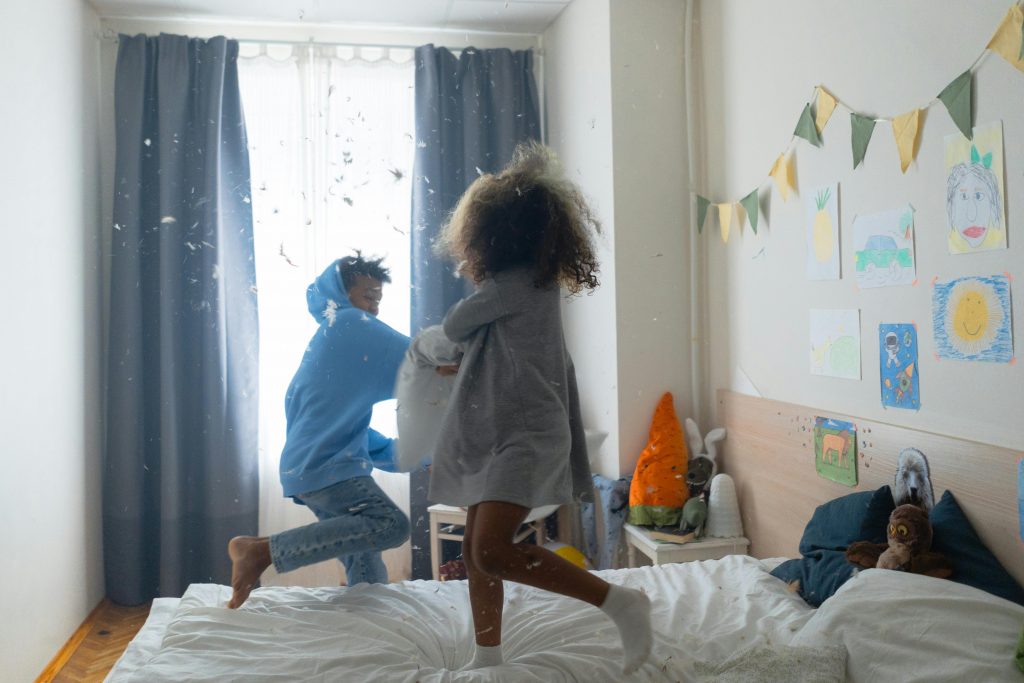Parents sometimes recoil at scenes of roughhousing — kids wrestling, tumbling, chasing — yet that kind of play may be one of childhood’s unsung developmental powerhouses. According to recent research, rough-and-tumble play (commonly referred to as roughhousing) is more than chaos. When guided well, it brings big benefits, teaches important life skills and builds stronger family bonds. But parenting this kind of play well means knowing when it helps, when it’s too much and how to draw useful boundaries.
What Exactly is Roughhousing?
Roughhousing refers to energetic physical play, like wrestling, chasing, tumbling, play fighting, conducted in a spirit of fun rather than aggression. Children engage with peers or parents, often nonverbally, testing physical strength, coordination and boundaries. Researchers note this is a play style seen across many mammal species.
The Benefits: More than Just Good Exercise
• Physical and motor development. Roughhousing helps children gain strength, agility, balance and coordination. It gives them a safe space to explore their physical capabilities and limits.
• Social intelligence and boundary recognition. In a properly monitored rough play session, kids learn to read facial expressions, body language, to initiate and respond, to negotiate stopping and consent. They distinguish play from aggression.
• Emotional regulation, resilience and self-control. Roughhousing introduces emotional highs, like excitement, competitiveness and frustration, and teaches children to manage those emotions. They learn impulse control and fairness, as well as how and when to back off.
• Cognitive benefits. Some studies suggest that children who engage more often in rough-and-tumble play show stronger working memory, better problem-solving and more effective risk assessment.
• Stronger bonds. Rough play between parent and child or siblings may promote closeness. According to Unplug and Play by Drs. Anthony DeBenedet and Lawrence Cohen, roughhousing “strengthens the bond between children and their parents, promoting a close connection essential for healthy development.”
When Roughhousing is too Much
Even with many upsides, roughhousing isn’t always benign. It crosses into trouble when physical or emotional harm becomes likely, when consent is absent or when rules dissolve.
• Risk of injury or overexertion. Young children especially may not understand their own strength or how others may feel pain. According to the University of Pittsburgh’s rough play guide, children don’t always know when play is getting too rough, so adults must intervene if safety becomes a concern.
• When consent or comfort is missing. If a child is pulling away, looks frightened or verbally or nonverbally signals “stop,” continuing play violates trust and can harm emotional development.
• Escalation into aggression. When competitive drive, jealousy or frustration take over, play may become aggressive rather than playful. That can teach harmful behaviors rather than healthy boundaries. Adults must watch for signs — harsh tone, angry faces, hitting intended to hurt — and quickly step in.
What Children Learn from Roughhousing
Roughhousing teaches much more than how to wrestle. It builds capacity for handling frustration, for reading social cues and for bouncing back from loss or being bested. These are skills that translate into school, friendship, team sports and later life. In fostering these, parents help children grow emotionally intelligent, socially adept, resilient and physically confident.
If parents allow roughhousing in a thoughtful way by guiding, supervising and setting rules, they offer kids more than just a chance to burn off energy. They offer a training ground for self-control, empathy, confidence and physical skill. Roughhousing done with purpose is not mere play. It’s preparation for life.

